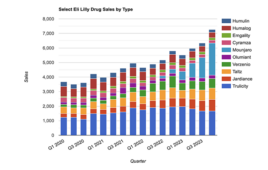 With drug-resistant bacteria on the rise, even common infections that were easily controlled for decades—such as pneumonia or urinary tract infections—are proving trickier to treat with standard antibiotics.
With drug-resistant bacteria on the rise, even common infections that were easily controlled for decades—such as pneumonia or urinary tract infections—are proving trickier to treat with standard antibiotics.
New drugs are desperately needed, but so are ways to maximize the effective lifespan of these drugs.
To accomplish that, Duke Univ. researchers used software they developed to predict a constantly evolving infectious bacterium’s countermoves to one of these new drugs ahead of time, before the drug is even tested on patients.
In a study appearing in the Proceedings of the National Academy of Sciences, the team used their program to identify the genetic changes that will allow methicillin-resistant Staphylococcus aureus, or MRSA, to develop resistance to a class of new experimental drugs that show promise against the deadly bug.
When the researchers treated live bacteria with the new drug, two of the genetic changes actually arose, just as their algorithm predicted.
“This gives us a window into the future to see what bacteria will do to evade drugs that we design before a drug is deployed,” said co-author Bruce Donald, a professor of computer science and biochemistry at Duke.
Developing pre-emptive strategies while the drugs are still in the design phase will give scientists a head start on the next line of compounds that will be effective despite the germ’s resistance mutations.
“If we can somehow predict how bacteria might respond to a particular drug ahead of time, we can change the drug, or plan for the next one, or rule out therapies that are unlikely to remain effective for long,” said Duke graduate student Pablo Gainza-Cirauqui, who co-authored the paper.
Because bacteria reproduce so rapidly—growing and dividing from one cell to two in less than an hour—drug-resistant bacteria are constantly evolving, and researchers have to constantly develop new ways to kill them.
Since the first antibacterial drugs were introduced in the 1940s, bacteria have evolved ways to resist every new antibiotic that has been developed—a process that has been accelerated by the use of antibiotics in livestock to help them gain weight, and in humans to treat viral infections that antibiotics are powerless to cure.
“My kids are now 15 and 13, and some of the antibiotics they were given when they were little aren’t given anymore because they aren’t as effective,” Donald said.
The percentage of infections caused by the bacterium Staphylococcus aureus that have proven resistant to treatment has risen steadily from just over 2% in 1975 and 29% in 1991 to more than 55% today—resulting in more than 11,000 deaths in the U.S. each year, a higher death toll than HIV.
“For some antibiotics, the first drug-resistant bacterial strains don’t appear for decades after the drug is introduced, and in others all it takes is one year,” Gainza-Cirauqui said.
Until now, scientists trying to predict the genetic changes that would enable a bacterium to evade a particular drug have had to look up possible mutations from “libraries” of resistance mutations that have been observed previously.
But this approach falls short when it comes to anticipating how bacteria will adapt to new drugs, where the microbes can’t be counted on to change in repeatable, predictable ways, Donald said.
“With a new drug, there is always the possibility that the organism will develop different mutations that had never been seen before. This is what really worries physicians.”
To overcome this problem, a research team led by Donald at Duke and Amy Anderson at the Univ. of Connecticut used a protein design algorithm they developed, called OSPREY, to identify DNA sequence changes in the bacteria that would enable the resulting protein to block the drug from binding, while still performing its normal work within the cell.
The team focused on a new class of experimental drugs that work by binding and inhibiting a bacterial enzyme called dihydrofolate reductase (DHFR), which plays an essential role in building DNA and other processes. The drugs, called propargyl-linked antifolates, show promise as a treatment for MRSA infections but have yet to be tested in humans.
“We wanted to find out what countermoves the bacteria are likely to employ against these novel compounds. Will they be the same old mutations we’ve seen before, or might the bacteria do new things instead?” Donald said.
From a ranked list of possible mutations, the researchers zeroed in on four tiny differences, known as single nucleotide polymorphisms, or SNPs, that would theoretically confer resistance. Though none of the mutations they identified had been reported previously, experiments with live bacteria in the lab showed their predictions were right.
When the scientists treated MRSA with the new drugs and sequenced the bacteria that survived, more than half of the surviving colonies carried the predicted mutation that conferred the greatest resistance—a tiny change that reduced the drugs’ effectiveness by 58-fold.
“The fact that we actually found the new predicted mutations in bacteria is very exciting,” Donald said.
The researchers are now using their algorithm to predict resistance mutations to other drugs designed to combat pathogens like E. coli and Enterococcus.
The model could also be expanded to anticipate a microbe’s response more than one move ahead, Donald said.
“We might even be able to coax a pathogen into developing mutations that enable it to evade one drug, but that then make it particularly susceptible to a second drug, like a one-two punch.”
Their computational approach could be especially useful for forecasting drug resistance mutations in other diseases, such as cancer, HIV and influenza, where raising resistant cells or strains in the lab is more difficult to do than with bacteria, the researchers say.
The software they developed, called OSPREY, is open-source and freely available for any researcher to use.
Source: Duke Univ.
Filed Under: Drug Discovery




